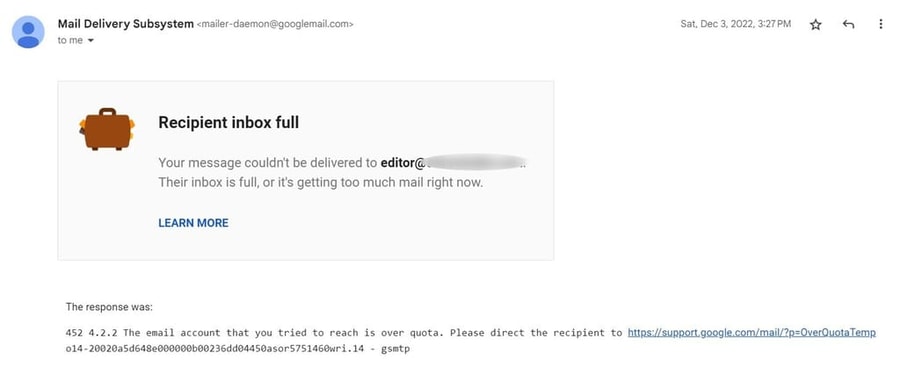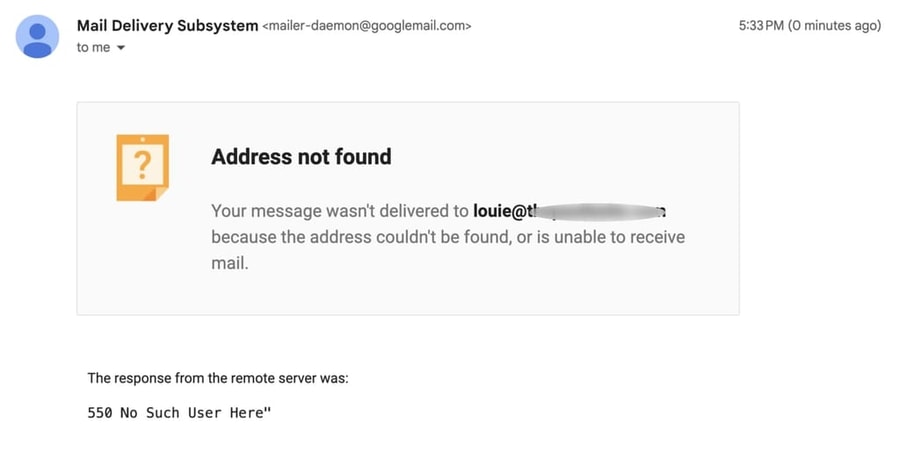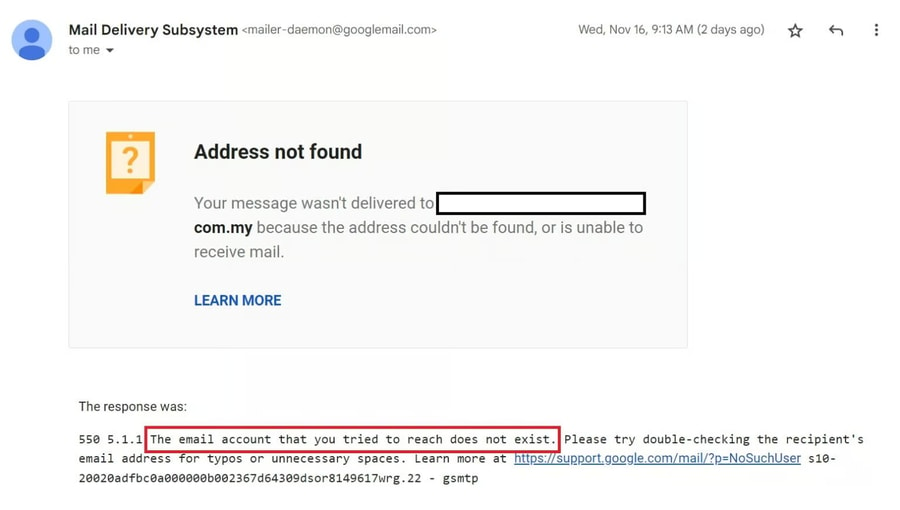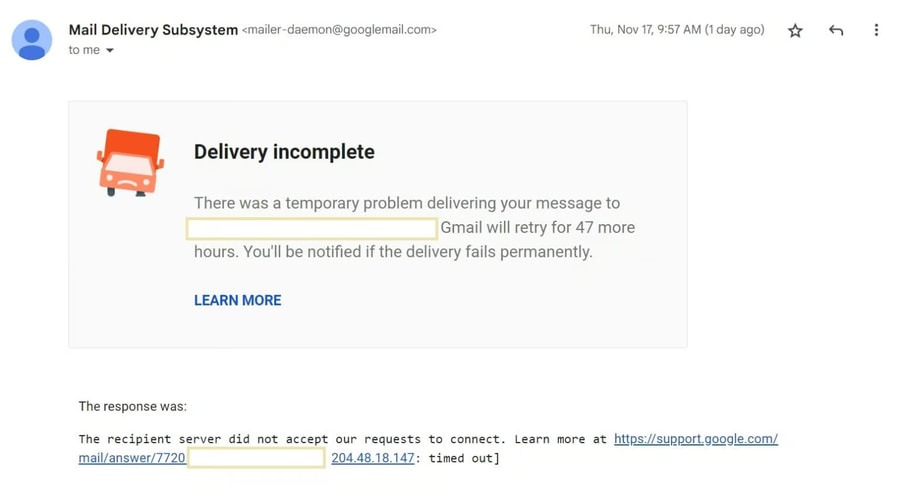Why Do Emails Bounce: Industry’s Best Practices and Pro Tips to Handle Them
Email is easy, personal, and fast – all it takes is writing a message and hitting “send.” But not every email gets to where it needs to go. Here, we look at how to deal with a bounced email and the steps you can take to avoid email bounces.
Did you know that 88% of people use email every day? It’s one of the reasons that, for businesses, email is hard to beat. There’s also tremendous potential for profit. Email has the highest ROI, with $36 for every $1 spent, with some industries regularly exceeding $40.
Email has almost limitless possibilities. It helps us establish valuable personal and professional connections. Businesses rely on email for just about anything:
- Transactional messages like invoices or shipping alerts
- Appointment reminders
- Sales and marketing offers.
However, there is one prerequisite for any email to work: the message must reach the recipient. Unless it reaches the person on the other end, your email only represents wasted time and expense. Emails bouncing are antithetical to the channel’s purpose.
What is a bounced email?
A bounced email is an email that does not reach its recipient. Typically, you get an automated message informing you that your email did not make it to the intended mailbox.
Think of it like trying to throw a basketball over a wall. If the ball got over, it would be received on the other end, which is your goal. If the wall blocks it, the ball bounces back to you.
When an email bounces, you get an automated message known as a bounce message informing you that your email wasn’t delivered. Each bounce provides a code explaining the reason, which helps senders diagnose the problem. For example:
SMTP Response Code: 550 5.1.1 – The email account you tried to reach does not exist.
What Is a good bounce rate?
A high bounce rate means fewer people see your emails, and worse, it can damage your sender reputation. Over time, this can lead to your IP being blacklisted, making it nearly impossible to reach your audience. Prioritizing a low bounce rate ensures your emails land in inboxes where they belong, driving engagement and results.
According to a recent study, hard and soft bounce rates vary by industry. However, when combined for each industry and averaged across the board, a total bounce rate of roughly 2% is considered average.
- Marketing emails: Less than 2%
- Transactional emails: Less than 1%
Here’s how to calculate your bounce rate:
Bounce Rate (%) = (Number of Bounced Emails ÷ Total Emails Sent) × 100
For example, if you send 1,000 emails and 15 bounce, your bounce rate is:
(15 ÷ 1,000) × 100 = 1.5%.
Staying within these benchmarks protects your sender reputation and ensures higher engagement and better results from your email campaigns.
Should I worry about bounced emails?
For some, email bounces are little more than a nuisance. The problem is that getting bounces sends a message to internet service providers (ISPs) that you’re a likely spammer. Why? Because spammers tend to send their messages carelessly, which may result in bounces.
When you get bounces in excess of 2%, ISPs think you’re a spammer. This leads to a decrease in your sender reputation. Sender reputations are used by email service providers (ESPs) as a way to determine who is sending spam and who is legitimate. Just because you aren’t a spammer doesn’t mean you won’t be regarded as such.
Be diligent to avoid sending emails to an address that will bounce. Before you send an email, make sure you have a working email address. Not only do you want to reach the person in question, but anything more than two bounces/100 emails will hurt your sender's reputation. You want your bounces to be as close to zero as possible.
Why do emails bounce?
There are so many reasons why your email bounced, and it can sometimes be challenging to determine exactly what happened. Here are some prominent reasons.
The address is invalid
Either you or the person you’re trying to reach has made a typo, which means the email address is invalid. For example, when you captured someone’s address, you wrote johhn@company.com instead of john@. Or maybe John himself gave you the wrong email.
Pro Tip: Use real-time email verification tools like ZeroBounce when capturing email addresses to catch typos or fake entries before they enter your list. For instance, tools can flag invalid formats like “johhn@company.com” instantly.

The message is too large
When the message is too large, it could be because you sent a large video file or tons of high-resolution pictures. The email you sent was too big for the inbox provider to accept.
Pro Tip: Compress large files or use links to cloud storage (e.g., Google Drive, Dropbox) instead of attaching bulky files. Keep emails concise with optimized images and file sizes to avoid size limits.
You have a low sender reputation
Your emails may bounce if you haven’t been following common sense email rules. The ISPs think of you as a spammer because you behave as much as they do. For instance, you may be getting bounces because you don’t maintain your email list.
Pro Tip: Improve your sender reputation by maintaining a clean email list, avoiding spammy practices, and authenticating your emails with SPF, DKIM, and DMARC protocols. Regularly monitor your sender score to stay in good standing.
The recipient does not exist
You emailed dave@, but there is no Dave in that domain. That email will definitely bounce unless the administrator has set up their domain as a catch-all. Catch-all domains accept all emails sent to a domain. Even then, having the wrong recipient could lead to a bounce.
Related: Learn more about catch-all emails.

If you send an email to a non-existent recipient, there’s a good likelihood your email will bounce.
Pro Tip: Use an email verification tool before sending emails to remove invalid addresses from your list. This step ensures you’re only sending to active, valid recipients and avoids unnecessary bounces.
The recipient blocked your email
Sometimes, you’ll receive a message that your email was blocked, and other times, it will simply bounce. If a recipient blocks you for any reason, there is a good likelihood that you will get a bounce.
Pro Tip: Monitor and resolve spam complaints to minimize the chances of being blocked. Always include an easy opt-out link in your emails to reduce the likelihood of recipients marking your emails as spam.
You are on a blacklist
You can end up on a blacklist simply by emailing what are sometimes called honeypots. They’re email addresses that are designed to lure spammers. Even if you don’t send spam but email one of these honeypots, you could be added to a blacklist which will lead to your emails bouncing.
Pro Tip: Regularly run blacklist checks to ensure your domain and IP address are not flagged. Tools like MXToolbox can help identify if you’re listed, and you can follow their removal processes to restore your sender reputation.
Related: How to run an email blacklist check
You have not implemented DMARC
Google and Yahoo’s updates on February 1, 2024, created new guidelines for mass emailing. DMARC stands for Domain-based Message Authentication, Reporting, and Conformance. If you haven’t set up DMARC, you could receive bounces or have your emails end up in the spam folder.
Pro Tip: Set up DMARC, SPF, and DKIM protocols to protect your emails and ensure compliance with major ISPs like Google and Yahoo. These measures validate your identity as a sender and significantly improve deliverability.
You encountered a DNS failure
A domain name system (DNS) failure can cause an email to bounce. Sometimes, DNS servers go offline, which can be caused by a malfunction at the data center. DNS issues are sometimes only temporary, but they can nonetheless cause a bounced email.
Pro Tip: Monitor your DNS records and set up alerts to detect server outages. Partner with a reliable DNS provider to minimize downtime and reduce the chances of email delivery disruptions.
You sent an email to a disposable email
Many people don’t want to give their real contact info. Instead, they use disposable or temporary emails, sometimes called burner emails.
These emails “self-destruct” after a day or even hours. If you send a message to a disposable email, it will bounce back. It’s one reason why keeping disposable emails off of your list makes a lot of sense. If someone doesn’t care enough to give you their real email address, you won’t have meaningful exchanges or do good business.
Pro Tip: Use email verification tools to detect and block disposable or burner emails during sign-ups. This will help maintain a clean, high-quality list and reduce the risk of unnecessary bounces.
Do bounced emails ever reach the recipient?
Getting a bounce means the email you intended to send did not reach the recipient. You should not consider the message or attachment you emailed to be in any way “delivered” if it bounced.
However, there is a specific type of bounce that isn’t definitive: a soft email bounce.
There are two types of bounces:
- hard bounces
- soft bounces
How are they different, and what should you be aware of? Let’s find out.
Types of email bounce: hard vs. soft email bounce rate
Before addressing any issues that may be causing a higher-than-average email bounce rate, it’s important to understand what a “bounce” actually is.
When it comes to email marketing, we need to distinguish between hard bounces and soft bounces.
1. A hard bounce is a permanent delivery failure.
A soft bounce is a temporary delivery failure. This means that the email has a chance of reaching the recipient in the future. Soft bounces frequently happen when the recipient’s mailbox is full, their server is down, or a spam filter blocks the email.
In the case of soft bounces, your email service provider will continue to attempt delivery. If it doesn’t succeed within 72 hours, your message will not reach that mailbox.
Pro Tip: Immediately remove hard bounce email addresses from your list to protect your sender reputation. Use email validation tools regularly to identify and clean outdated or invalid addresses before sending campaigns.

2. Soft bounces, on the other hand, are a temporary form of delivery failure.
A hard bounce is a permanent delivery failure, meaning your email will never reach the recipient. There are a few hard-bounce reasons. The email address may be invalid, mistyped, or currently nonexistent.
A hard bounce indicates you should remove the email address from your contact list and not attempt to send any more emails to it.
Pro Tip: Monitor soft bounces to identify patterns or recurring issues. If the bounce persists after several attempts, temporarily suppress the address and try again later. Keeping your email size small and content optimized can also reduce the chances of a soft bounce.

Related: Learn more about the difference between soft bounces and hard bounces
Why are my Gmail emails bouncing back?
Gmail is by far the most popular email service provider. Chances are you have lots of Gmail contacts in your database. And if you’ve noticed an unusually high Gmail bounce rate, you’re not alone.
In an effort to keep security threats down – like phishing and spam– Google began mass-deleting inactive accounts. If you have many dormant subscribers in your list, their emails may be bouncing now due to Google’s initiative.
Why are my Yahoo emails bouncing?
Before the Gmail purge, Yahoo was cleaning its own house. In 2019, the tech giant started deactivating and deleting inactive email accounts. This resulted in massive bounce rates for businesses that stored and emailed old contacts.
ZeroBounce spoke with Marcel Becker of Yahoo, who commented that senders shouldn’t be holding on to dormant accounts in the first place. Removing them regularly prevents you from getting bounces.
Tips on How to Handle Bounced Emails?
By now, you know bounces hurt your sender reputation and block your future campaigns and newsletters from landing in the inbox. So, how can you prevent email bounces? Here are some important tips for you to prevent email bounces.
Validate your entire email database
Start improving your email list health today with ZeroBounce’s email validation tools. Here’s how:
- Upload Your Email List: Import your contact list directly into ZeroBounce’s platform.
- Run the Validation: ZeroBounce will scan your list to identify invalid, disposable, and risky email addresses.
- Review Results: Receive a detailed report highlighting which emails to keep and which to remove.
By using ZeroBounce, you’ll proactively prevent bounces, improve your sender reputation, and maintain a healthy list.
Consider making email validation a habit. On average, a quarter of your email contacts go bad every year.
Validate emails in real time
Verifying your email list in bulk every quarter will help you avoid bounced emails. But if you want to go a step further, consider real-time email validation. To check emails in real time, connect an API to every form where you collect email addresses. If your forms are unprotected, you’ll acquire poor-quality data. A real-time email validation API can stop bad contacts from infecting your list.
An email validation API ensures that every new contact you gather is real and valid.
- Connect ZeroBounce API to Your Forms: Add the API to all your signup and contact forms to instantly check and validate incoming email addresses.
- Prevent Poor-Quality Data: Block typos, invalid addresses, and disposable emails before they reach your list.
- Protect Your Sender Reputation: Real-time validation keeps your list clean, ensuring better deliverability and engagement.
You can use a free email verifier
An email validation API can stop invalid emails from getting on your list from the beginning.
Not everyone’s email list grows at the same rate. Whatever the purpose of your list, you can make an impact with even a few dozen subscribers.
However, you should routinely check email addresses for freshness. If your email database is growing slowly, consider using a free email verifier to check each contact before adding them to your list.
Build an opt-in list
When starting, you may have come across websites offering to sell you a list that you’ve purchased or tools to “scrape” contact details from various websites. While these methods might seem like an easy way to grow your audience, they come with serious risks. Purchased lists often contain outdated or invalid email addresses, which can lead to high bounce rates and harm your sender reputation. Worse, emailing contacts who never opted in can trigger spam complaints and even get your IP blacklisted.
Instead, focus on building your list through an opt-in system. Subscribers who actively choose to receive your content are far more likely to engage and convert. While it may take longer, creating an opt-in email list ensures you connect with a receptive audience, improving delivery and long-term success. Avoid risky shortcuts and prioritize quality over quantity.
Not sure if your email list needs cleaning? Get a free evaluation
If you’ve never cleaned your list or don’t have any idea where to start, try a free email list evaluator. You can upload your list, and it will give you a free assessment and let you know what is lurking there.

Or maybe you were using a list and stopped emailing those people for a few months. Before you resume sending, get a thorough evaluation of your email list. Otherwise, you may get many bounced emails and jeopardize your future campaigns.
Tools to Manage Email Bounces
By using these tools strategically, you can prevent bounces, maintain a clean email list, and protect your sender reputation.
Verification Tools
- ZeroBounce: ZeroBounce identifies invalid, disposable, and abuse-prone addresses to ensure only valid emails remain in your list.
- BriteVerify: BriteVerify scans your email lists for inaccuracies and invalid addresses, preventing unnecessary bounces.
Monitoring Tools
- Google Postmaster Tools: It provides insights into bounce rates, spam feedback, and sender reputation.
- Sender Score by Validity: It assigns a numerical score to your domain based on delivery metrics, helping identify issues contributing to bounces.
Testing Tools
What you need to remember about email bounces
If you’re just starting to learn about bounced emails and how to avoid them, this may have been a lot of information for you. To make things easier, here are the main points to remember:
- Email bounces are delivery failures that occur when an email cannot reach the recipient’s inbox.
- There are two types of bounces: hard and soft. Hard bounces are permanent and result from invalid or non-existent email addresses. Soft bounces are temporary and result from issues at the recipient’s end, such as a full inbox, a server problem, or a content filter.
- Bounces can harm your email marketing performance and reputation. They can lower your sender score and deliverability and affect your engagement and conversion rates. To avoid them, you must follow some best practices, such as using a reputable email service provider, regularly verifying your email list, segmenting your audience, and optimizing your email design and content.
- You can never completely stop bounces, but you can (and should) prevent most of them.
We hope you found this article useful and informative. To learn more about avoiding bounces, check out The Ultimate Guide to Email Hygiene and Scrubbing.

Zach is the manager and coordinator of (nearly) all things content-related at ZeroBounce. He works closely with all teams, from marketing to design to web development, to quickly deploy written and visual content that communicates how ZeroBounce brings value to your business. Zach has seven years of experience in digital marketing, crafting content for a wide variety of small-to-medium-sized businesses, including healthcare, finance, tech, SaaS, and real estate. When he's not writing, you can find him at the gym, playing or listening to music, or seeking out his next compelling TV show to binge-watch.